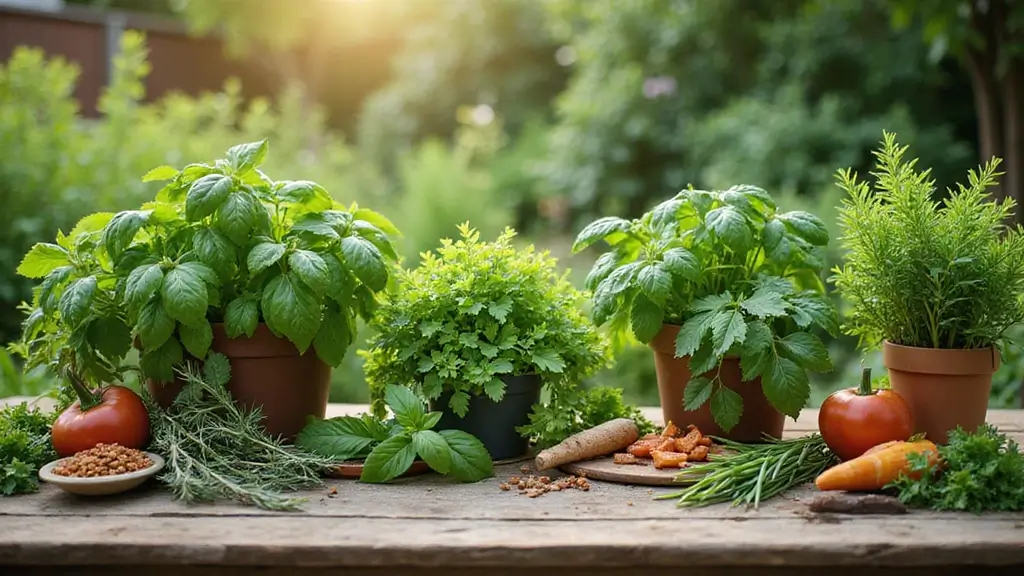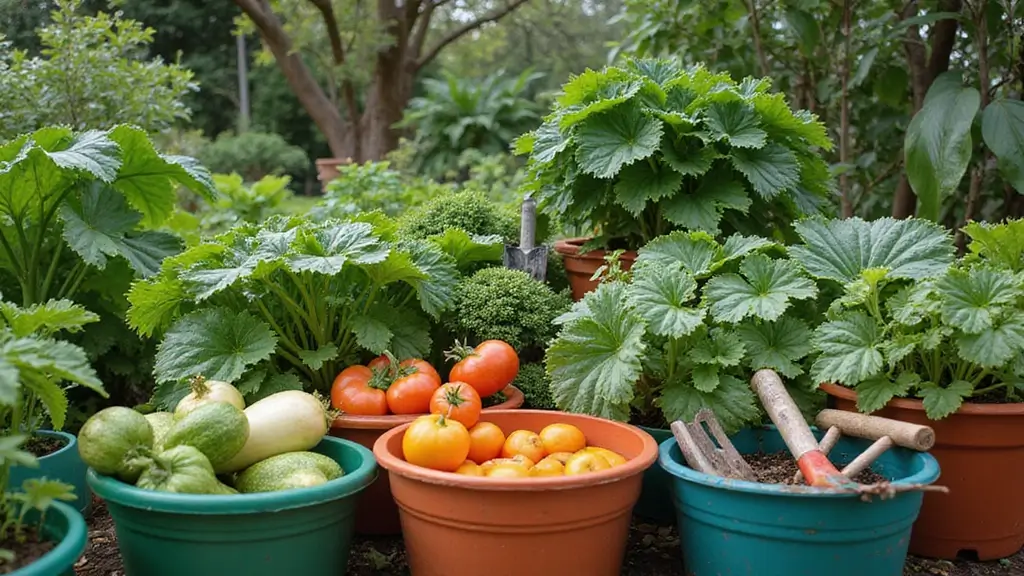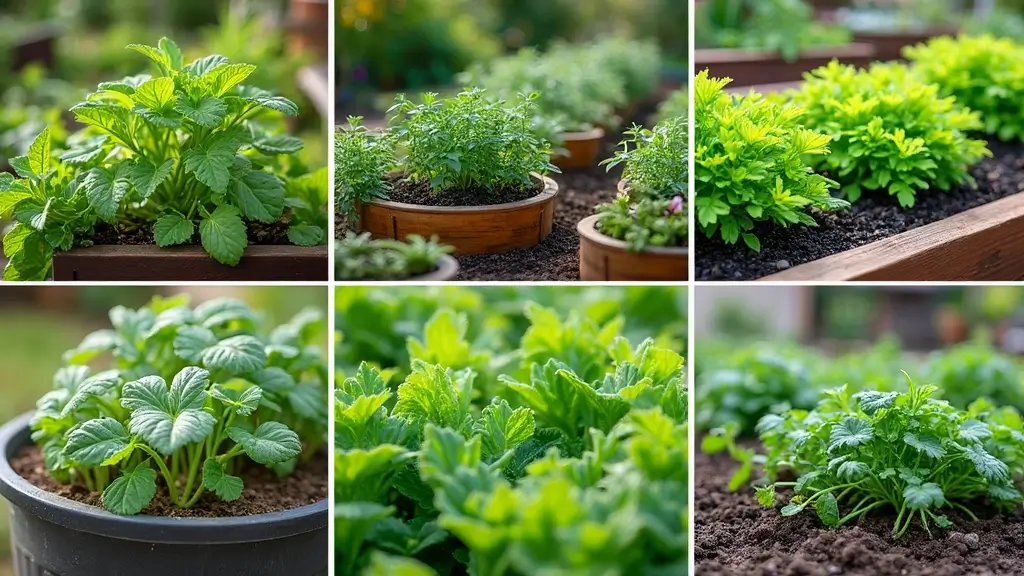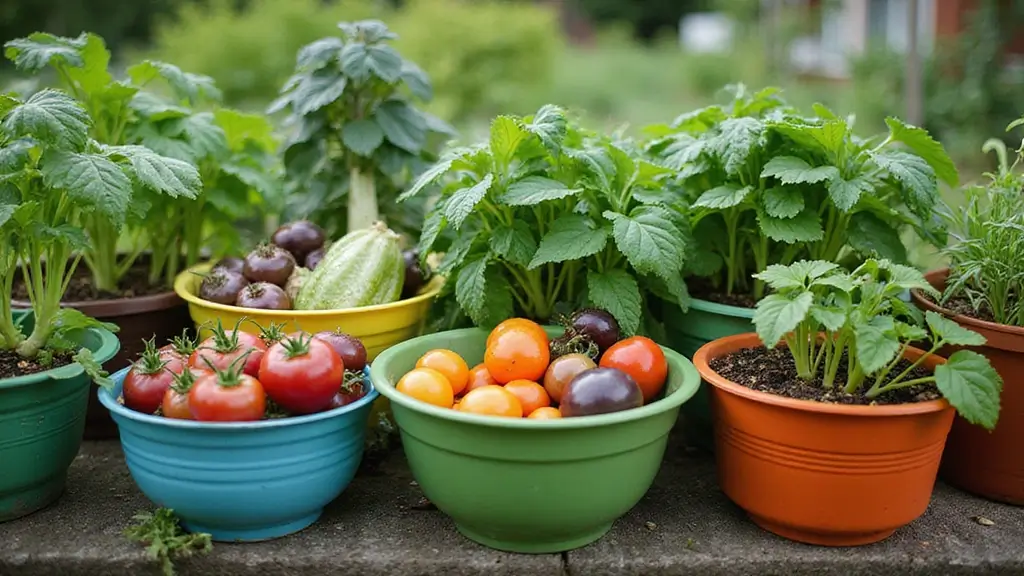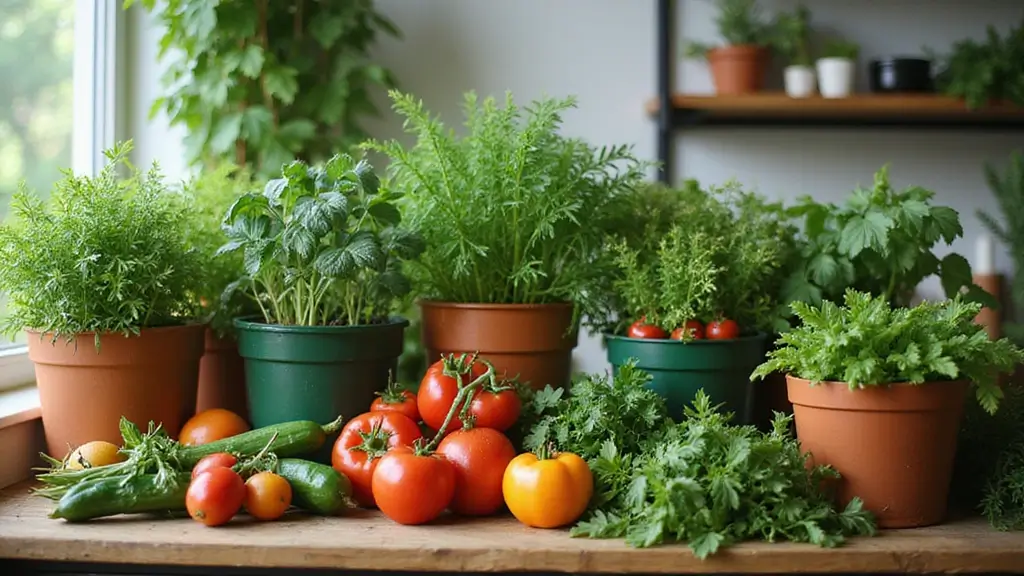There’s something truly special about snipping fresh herbs right from your own garden, elevating your dishes with unique flavors.
Creating an herb garden can turn your cooking into an adventure, enhancing the taste of everything from soups to salads.
Whether you’re a seasoned chef or a kitchen newbie, the right herbs can add magic to your meals. Using various gardening techniques not only spices up your culinary creations but can also beautify your space.
Let’s explore these vibrant herb garden ideas that are sure to make your cooking more exciting and your garden more stunning!
1. Vertical Herb Garden
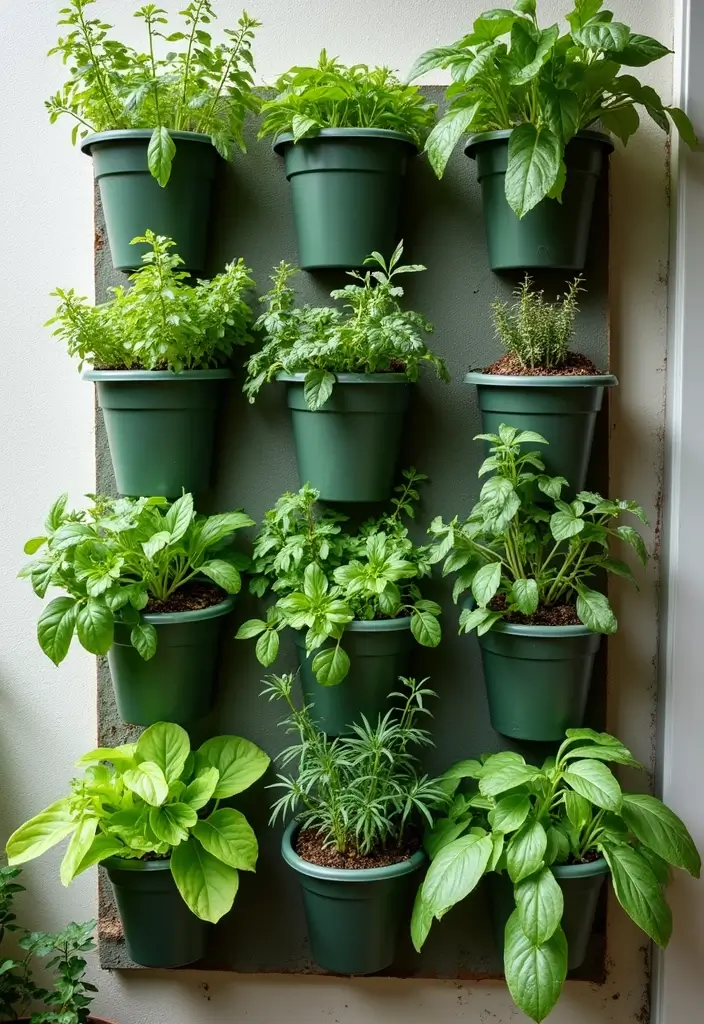
Space can be tight, but who says you need a sprawling yard? A vertical herb garden allows you to grow herbs upward, saving precious ground space while creating a stunning visual feature. You can use wall-mounted planters like the PlantPod Luxe – Self-Watering Wall Planters (Set of 6), which are lightweight and easy to install. This makes watering a breeze, and they allow you to design your own vertical garden with minimal effort.
Consider incorporating repurposed wooden pallets or hanging pockets to make your garden truly stand out. This method is especially appealing for herbs like basil, mint, and parsley, which thrive in smaller spots. Not only does this approach beautify an outdoor space, but it can also be adapted for indoor areas, brightening up kitchens and balconies alike.
When choosing herbs, select those that thrive in similar conditions to simplify care. You might also find the 8 Herb Garden Kit particularly helpful, as it includes non-toxic pots and organic seeds, providing everything you need to get started with your indoor herb planter.
Ensure your structure is strong enough to support the weight of the plants as they grow, and feel free to paint the planters in bright colors to add character. With the right tools and a little creativity, your vertical herb garden can flourish in any space you have!
2. Herb Spiral
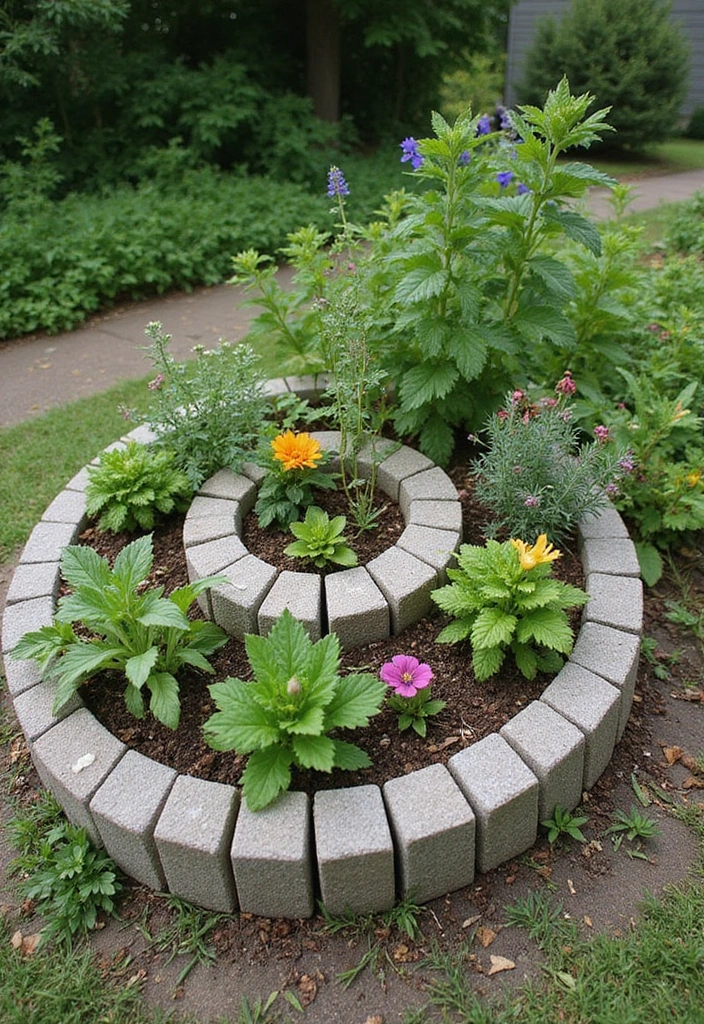
The herb spiral is not only functional but also a delightful focal point in your garden. This design creates a microclimate, allowing you to grow a variety of herbs in a compact space.
Building an herb spiral involves stacking stones or bricks in a spiral shape and filling it with soil. For the perfect foundation, consider using stackable garden stones, like the Happy Gardens Zen Stacked Rocks Sculpture. These stones not only provide structural support but also add an aesthetic touch, enhancing the visual appeal of your garden.
The higher areas of the spiral will be drier, perfect for herbs like thyme and rosemary, while the inner, lower parts will hold moisture, accommodating water-loving herbs such as basil and cilantro. To ensure your herbs thrive, fill your spiral with quality soil, such as Garden Soil Mix from Back to the Roots. This organic potting mix is designed to provide the optimal growing environment for your herbs.
The winding structure is lovely, encouraging curious garden exploration. Plus, as an added bonus, the spiral can attract beneficial insects, enhancing your herb garden’s ecosystem.
When planting, arrange herbs based on their water needs and consider letting plants spill over the sides for extra visual appeal. For those just starting out, an herb planting kit can be a fantastic way to grow ten different kitchen herbs in a convenient indoor setup, making it easy to enjoy fresh herbs year-round.
This approach not only saves space but also invites garden visitors to interact with your plants in an engaging way.
3. Container Herb Garden
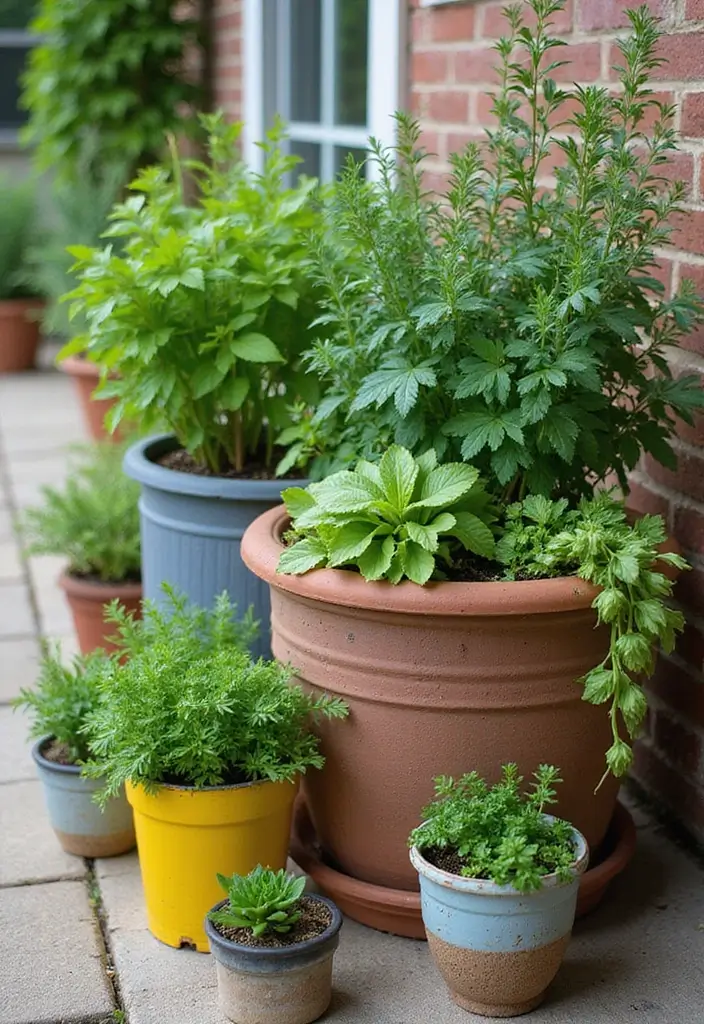
Container gardening provides flexibility and control over your herbs. You can use pots, bins, barrels, or even repurpose old wooden crates to create your herbal oasis. For an effortless experience, consider using self-watering planters with drainage holes. These planters come in various sizes, ensuring that your herbs, such as basil, chives, and mint, thrive without the worry of overwatering.
This method allows you to move your herbs according to sunlight needs or seasonal changes, making the arrangement of pots on patios, balconies, and windowsills easy. You can also opt for herb garden starter kits, which include everything you need—pots, soil, and tools—perfect for setting up your container garden on a kitchen countertop or windowsill.
Containers come in all shapes and sizes, allowing you to customize your garden’s look. For a modern aesthetic, check out decorative plant pots that are not only stylish but also practical, featuring drainage to keep your herbs healthy. Ensure your containers have drainage holes to prevent waterlogging, and consider grouping herbs with similar water needs in one container for easier maintenance.
Let your creativity shine with colorful pots or whimsical designs to match your personal style while enjoying the convenience of container gardening.
4. Herb Garden in a Wooden Pallet
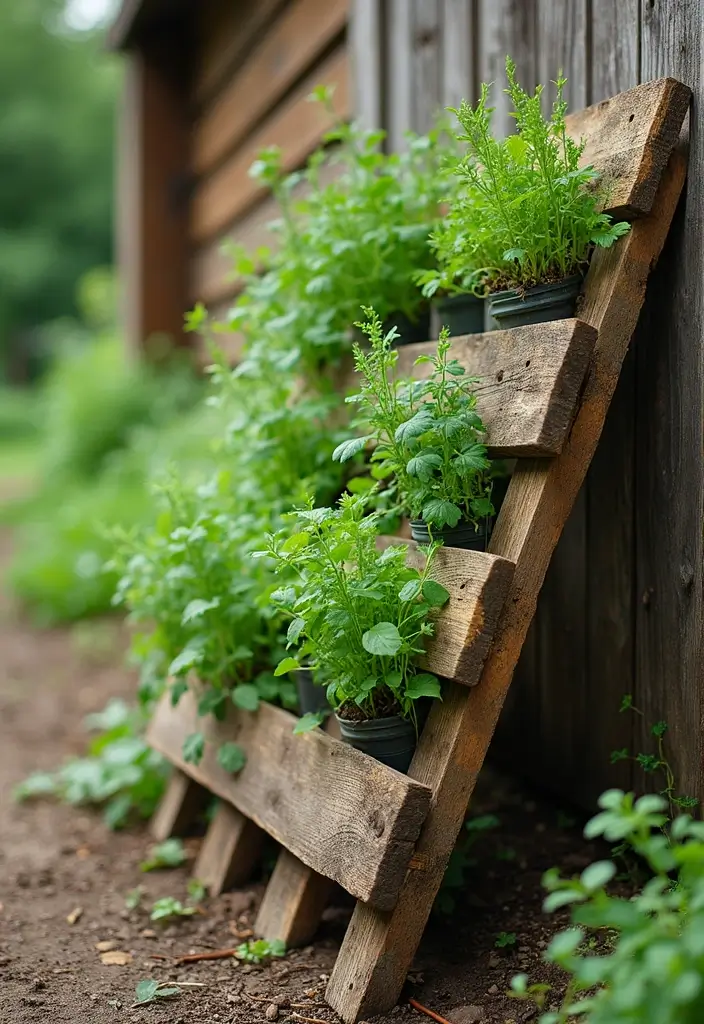
Give a rustic charm to your garden by creating an herb garden in a wooden pallet. This idea is not only eco-friendly but also stylish and functional.
Simply fill the pallet with soil and plant your favorite herbs in the slats. Thyme, oregano, and sage are excellent choices as they don’t require deep soil. To get started, consider using a wooden pallet planter that offers durability and a beautiful aesthetic with its acacia wood construction.
Position the pallet against a wall or fence to maximize space and add an interesting vertical element to your garden. For your herb planting needs, a herb seeds variety pack can provide a range of culinary herbs for you to grow, ensuring you have a delightful selection at your fingertips.
Enhance the design by adding small wheels to the bottom of the pallet, making it mobile for easy access to sunlight or rain. The garden wheels for planters are a great addition for this purpose, allowing you to effortlessly move your herb garden around your outdoor space as needed. You can also paint or stain the pallet to match your garden decor.
This project is not only budget-friendly but also provides a delightful rustic aesthetic to any backyard!
5. Indoor Herb Garden
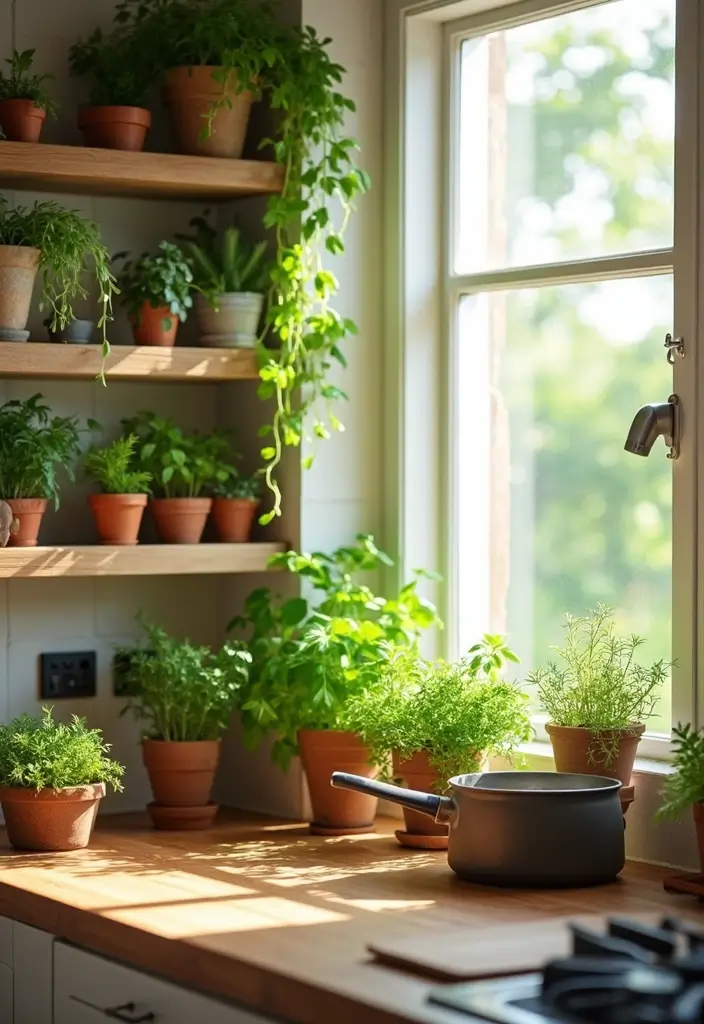
Bring the freshness of herbs indoors with an indoor herb garden! This is perfect for those who may not have outdoor space but still want to enjoy fresh herbs in their cooking.
You can create a sunny nook in your kitchen filled with pots of basil, cilantro, and parsley. Utilizing a tiered plant stand can make it easier to maximize space, allowing each herb to get adequate sunlight exposure while adding a decorative touch to your kitchen.
For low-light conditions, consider using a LED grow light. This full-spectrum lamp ensures your indoor herbs thrive even when sunlight is limited, helping you cultivate a vibrant garden year-round.
Keep herbs in small pots, such as the herb pot set, to ensure they stay healthy and manageable. Regularly pruning herbs will encourage bushy growth and prevent them from becoming leggy.
Creating an indoor herb garden also means you always have fresh ingredients at your fingertips, making your culinary tasks more enjoyable!
6. Herb Garden on a Windowsill
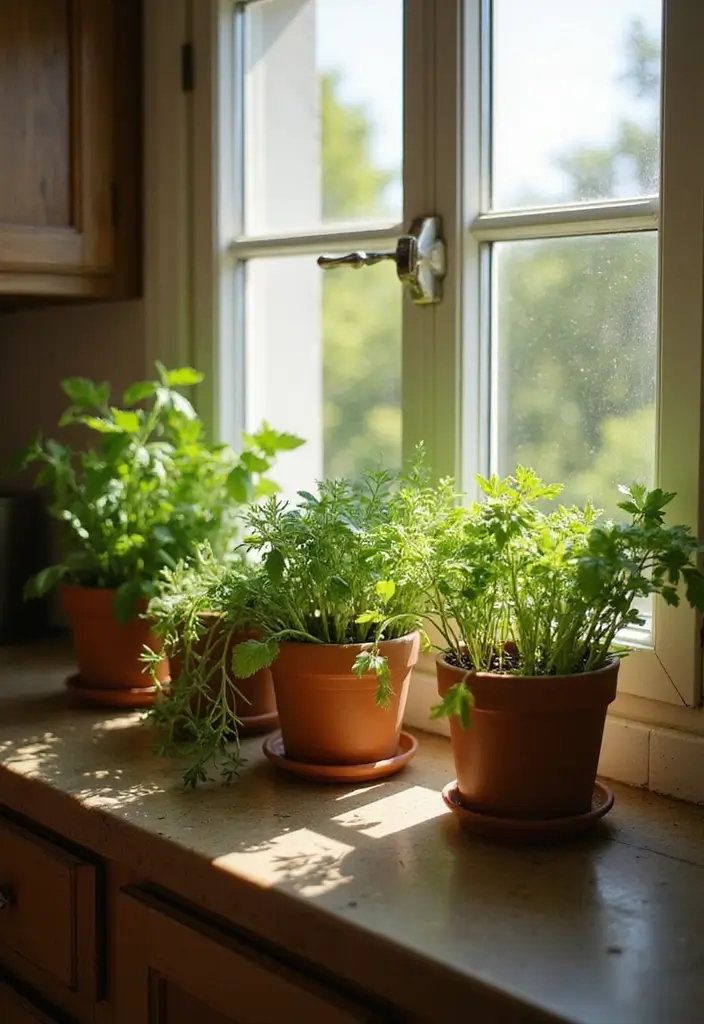
A windowsill herb garden is a perfect option for those living in apartments or homes with limited space. It allows you to enjoy the beauty and benefits of growing your own herbs without taking up too much room.
Choose a sunny spot on your windowsill and plant basil, chives, and mint in small pots. A sunny south-facing window is ideal for these herbs to thrive. To help manage your watering, consider using self-watering pots. These pots come with a drainage system and a water level indicator, ensuring your herbs stay hydrated even when your schedule gets busy.
This setup not only adds a touch of greenery to your home, making it look more inviting, but it also provides easy access for cooking, encouraging you to use your fresh herbs more often. If you’re looking to start your herb garden, an herb seed starter kit is a great option. It features a variety of non-GMO heirloom seeds perfect for indoor and outdoor gardening.
If natural sunlight is a concern, especially during darker months or in less sunny areas, you might want to invest in an indoor grow light. This full-spectrum light mimics sunlight and can help your herbs thrive regardless of the natural light available.
A windowsill herb garden creates a lovely splash of green and enhances your cooking experience while these products support your gardening journey!
7. Herb-Infused Garden Bed
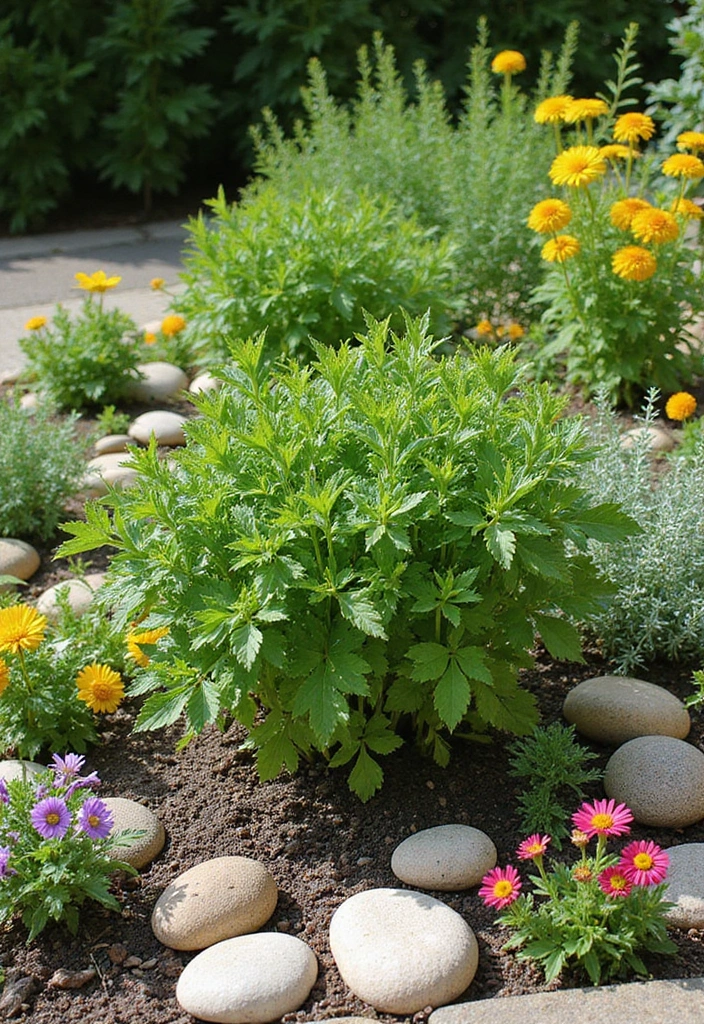
Create a dedicated herb bed in your garden to grow a variety of herbs in one charming spot. This garden bed can become an aromatic sanctuary, perfect for cooking and enhancing flavors. To get started, consider using a raised garden bed kit that provides a structured space for your herbs, making it easier to manage your gardening routine.
Choose herbs like rosemary, thyme, and dill, which can thrive together and have similar sunlight and watering needs. Organizing herbs based on their heights can create a beautiful layered effect. To add visual appeal while deterring pests, incorporate a border of flowers or decorative stones. This is where a garden mulch mat can come in handy, as it helps retain moisture and suppress weeds around your herbs.
Regularly harvesting your herbs encourages new growth, ensuring you always have fresh ingredients at your fingertips. Consider growing a variety of herbs with the organic herb seeds variety pack, which includes essentials like basil, cilantro, and oregano for your kitchen.
Having a dedicated herb bed can not only enhance your cooking but also become the centerpiece of your garden!
8. Herb Garden with a Trellis
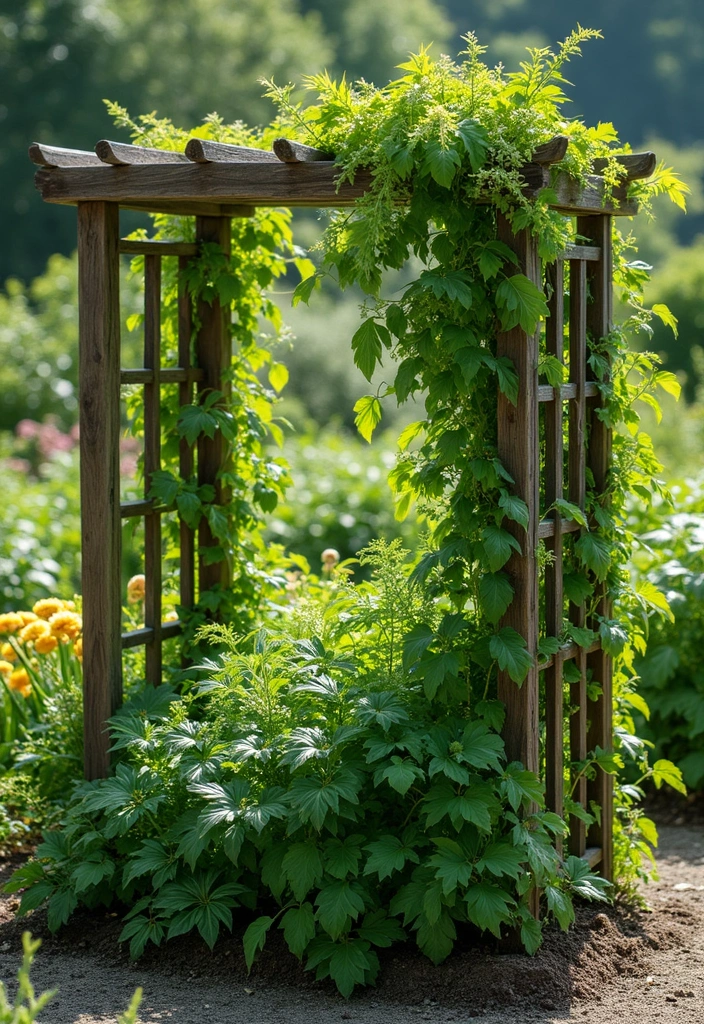
Incorporate a trellis into your herb garden design to add vertical interest and help certain herbs climb, optimizing your garden space. Climbing herbs such as peas, beans, or even vine-like varieties of basil can beautifully adorn a trellis and create a stunning backdrop.
Using a Wooden Garden Trellis not only supports the plants but also allows for better airflow and sun exposure, which can lead to healthier herbs. You can craft a trellis from wood or wire, making it as simple or complex as you like.
To encourage upward growth, plant climbing herbs at the base of the trellis. Adding some light twine or netting can assist the herbs in climbing effectively. For this purpose, consider using Garden Twine, which is perfect for guiding your plants as they grow. Alternatively, Plant Support Netting provides a sturdy framework, ensuring that your climbing herbs have the support they need.
This method not only maximizes your garden space but also creates a beautiful, lush look that’s pleasing to the eye.
9. Herb Garden with Companion Plants
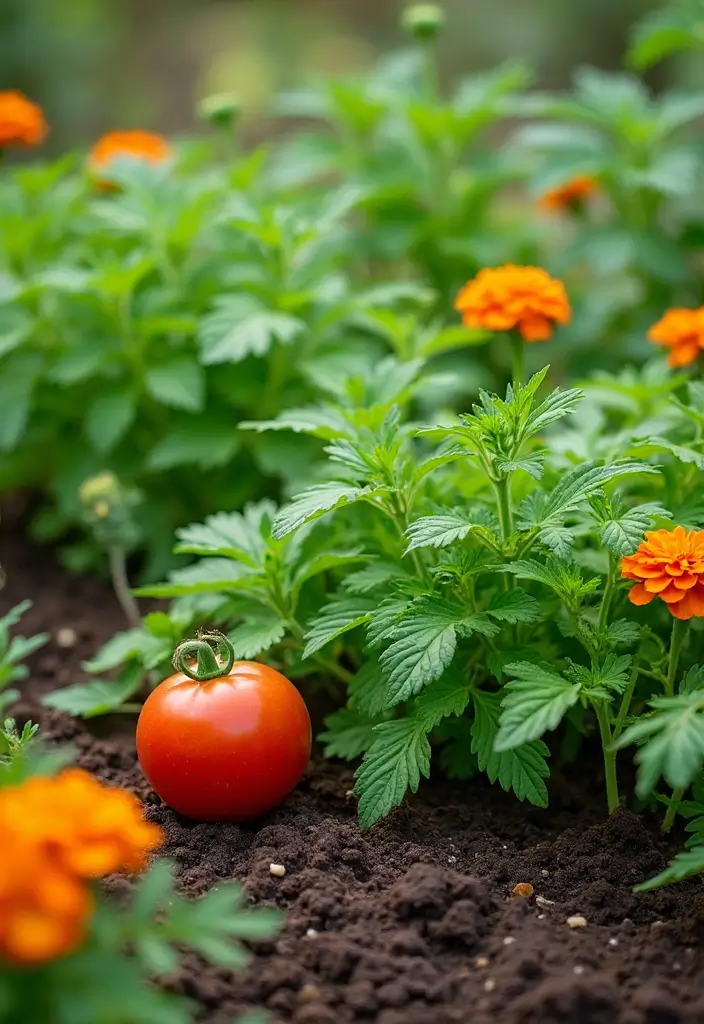
Companion planting is a fantastic strategy to create a healthy and productive herb garden. Some herbs do well when planted alongside specific vegetables or flowers, creating a beneficial ecosystem.
For example, basil pairs beautifully with tomatoes, enhancing their growth and flavor. Similarly, rosemary can deter pests from reaching nearby cabbages. By combining these plants, you can create a thriving herb garden that requires less maintenance while boosting plant health. To help you get started, consider the herb garden starter kit, which includes pots, soil, and tools for your indoor garden, perfect for a windowsill or countertop.
Tip: Research compatible plants before planting to maximize benefits. Using resources like the organic companion planting guide can help you identify which herbs and plants work well together, ensuring a productive garden.
Companion planting not only aids in pest control but can enhance flavor and yield. To provide ample space for your herbs and their companions, consider using a raised garden bed planter. This will give your plants plenty of room to grow while keeping the garden organized and accessible, making your gardening experience both productive and enjoyable.
10. Herb Garden Kits for Beginners
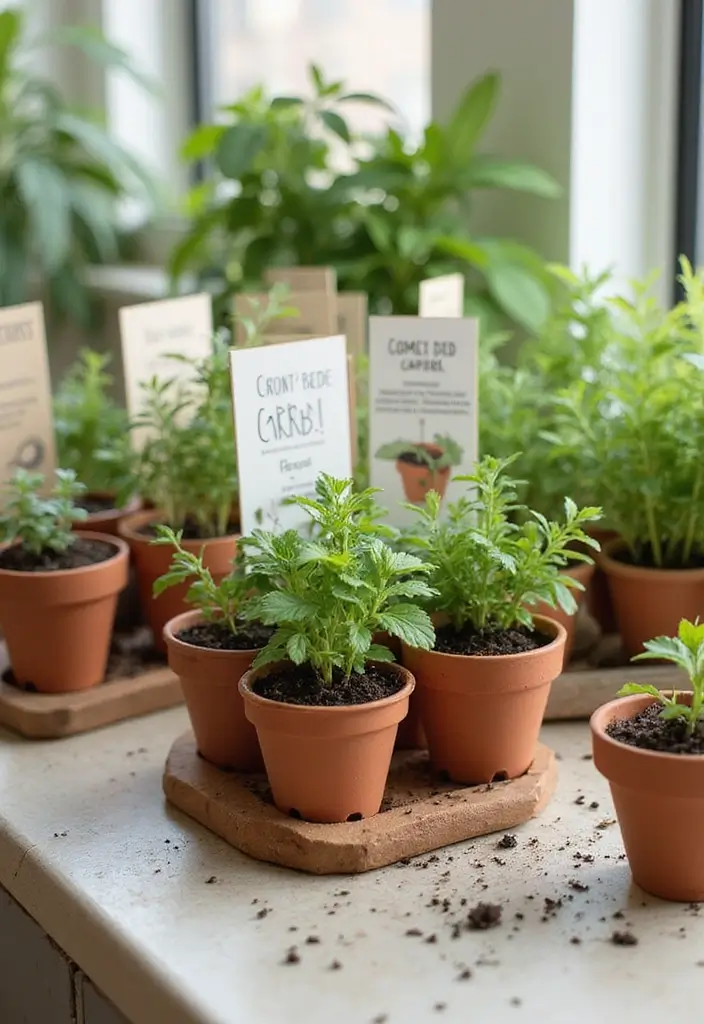
If you’re just starting out, investing in an herb garden kit might be the best choice. These kits often come with everything you need to grow your own herbs, including seeds, pots, soil, and even labels. For example, the Herb Garden Starter Kit provides a complete starter set that’s perfect for your windowsill or countertop gardening.
Look for kits that feature easy-to-grow herbs like basil, parsley, and cilantro, which are ideal for beginners. Following the included instructions can help you avoid common mistakes, ensuring you have a successful first garden. Additionally, if you want to experiment with a variety of herbs, consider the Organic Herb Seeds Variety Pack, which includes non-GMO, heirloom seeds like basil, cilantro, and oregano.
These kits are not only convenient but also serve as an excellent gift for aspiring gardeners. Tip: Start small; focus on growing a couple of herbs before expanding your collection. You might also want to consider using self-watering planters for herbs. These planters help ensure your plants receive the right amount of moisture, making it easier to care for your herbs.
Starting with a garden kit can make your journey into herb gardening smooth and enjoyable!
Starting your herb garden is as easy as 1-2-3! With a beginner’s kit, you get seeds, pots, and guidance—everything you need to grow a tasty culinary adventure right at home!
11. DIY Hanging Herb Garden
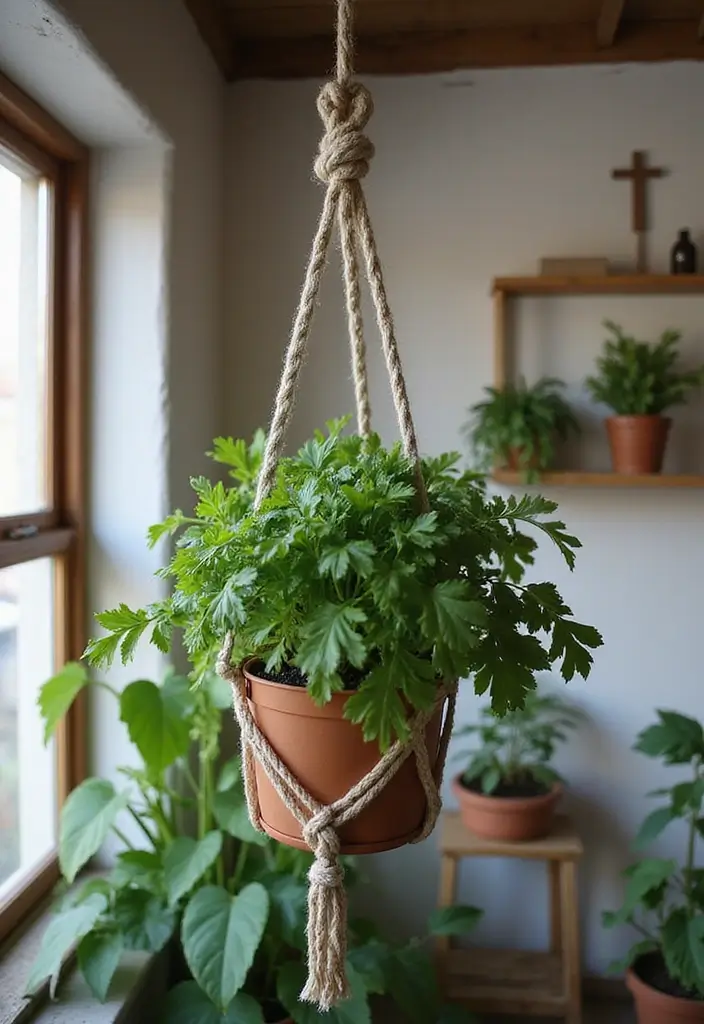
A DIY hanging herb garden adds a fun twist to traditional gardening methods. By using hanging baskets like the hanging planter baskets or macrame holders such as the macrame plant hangers, you can create a stunning display of herbs that saves space and adds beauty.
Choose herbs like mint, chives, and oregano, which look fabulous cascading down from their holders. Hang them in bright or rustic areas to create a visual impact. This setup can be used both indoors and outdoors, allowing you to grow herbs wherever you have a bit of overhead space.
To ensure a successful garden, consider planting your herbs in the indoor herb growing kit, which features a quiet smart water pump and automatic timer to keep your herbs healthy and thriving with minimal effort. Tip: Ensure the baskets have good drainage and are hung in a spot where they can get plenty of light.
A hanging herb garden not only saves space but also adds a creative flair to your gardening style!
12. Herb Garden with Natural Borders
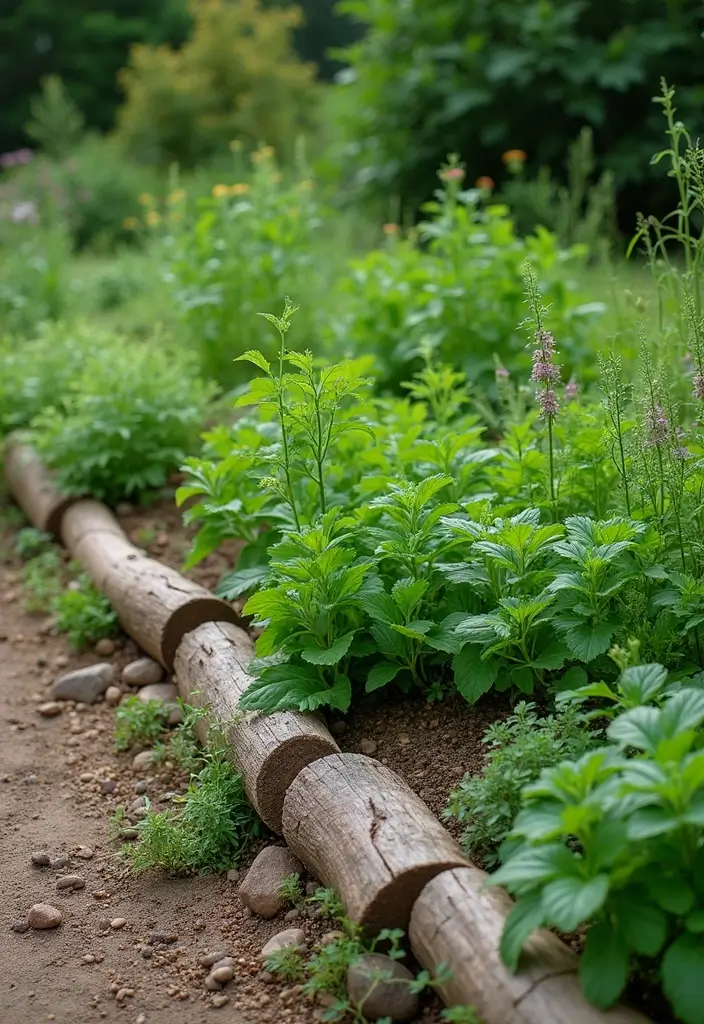
Using natural borders in your herb garden can create a charming, rustic look. Instead of traditional fencing, opt for logs, stones, or bricks to define your herb garden space. A great option for this is the Garden Edging Stones, which can provide a decorative stone-look while keeping your herbs neatly contained.
This approach creates a seamless integration of your herbs with the surrounding landscape, giving it a natural feel. Choose herbs like thyme or lavender that thrive in such conditions and will benefit from the additional warmth provided by the borders. You can start your herb garden with the Herb Garden Starter Kit, which includes pots, soil, and tools all in one convenient package, making it perfect for your gardening adventure.
Consider planting flowers along the border for added color and to attract more pollinators to your garden. To enhance your garden, include some Organic Thyme Seeds in your planting mix. This not only adds to the aesthetic appeal but also ensures you have fresh herbs readily available for your cooking.
Your herb garden will not only be functional but also a beautiful feature in your yard. Utilizing natural borders can enhance your garden’s aesthetics while promoting healthier growing conditions!
13. Herb Garden with a Water Feature
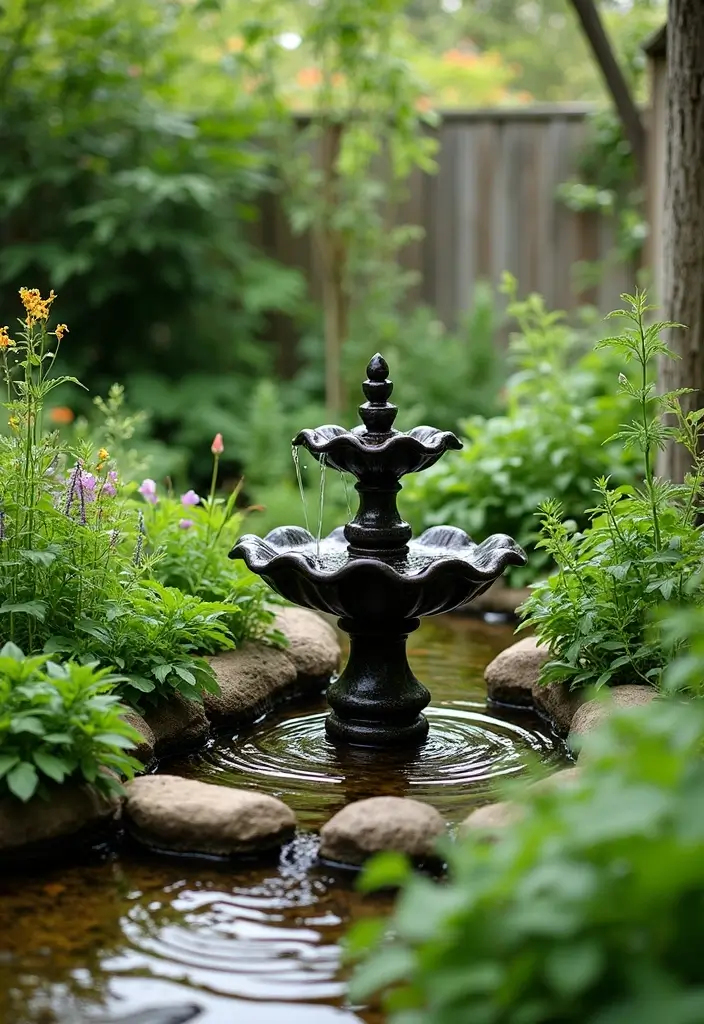
Imagine the sound of gently flowing water mingling with the aromatic scents of fresh herbs. Adding a water feature, like the Alpine Corporation – outdoor rustic 2-tiered barrel and pump water fountain, can enhance the atmosphere of your herb garden, creating a serene space. This small outdoor fountain, standing at 27 inches tall, offers relaxing water flow that can transform your garden into a tranquil retreat.
Growing herbs such as basil, mint, and cilantro near water sources can also help keep them hydrated, creating a thriving growing environment. To complement the water feature, consider incorporating some decorative stones for landscaping. These 20 lbs of large river rocks, measuring 3-4 inches, can be used around the fountain to enhance the visual appeal of your garden. Their natural look not only adds beauty but also helps with drainage and keeping the area tidy.
Tip: Choose a water feature that suits your garden size—small fountains can create a lovely ambiance without overwhelming the space. Incorporating a water feature into your herb garden can be a truly delightful addition!
Create a tranquil herb garden by adding a water feature – the gentle sound of flowing water paired with fresh herbs not only nurtures your plants but also soothes your soul!
14. Herb Garden with Edible Flowers
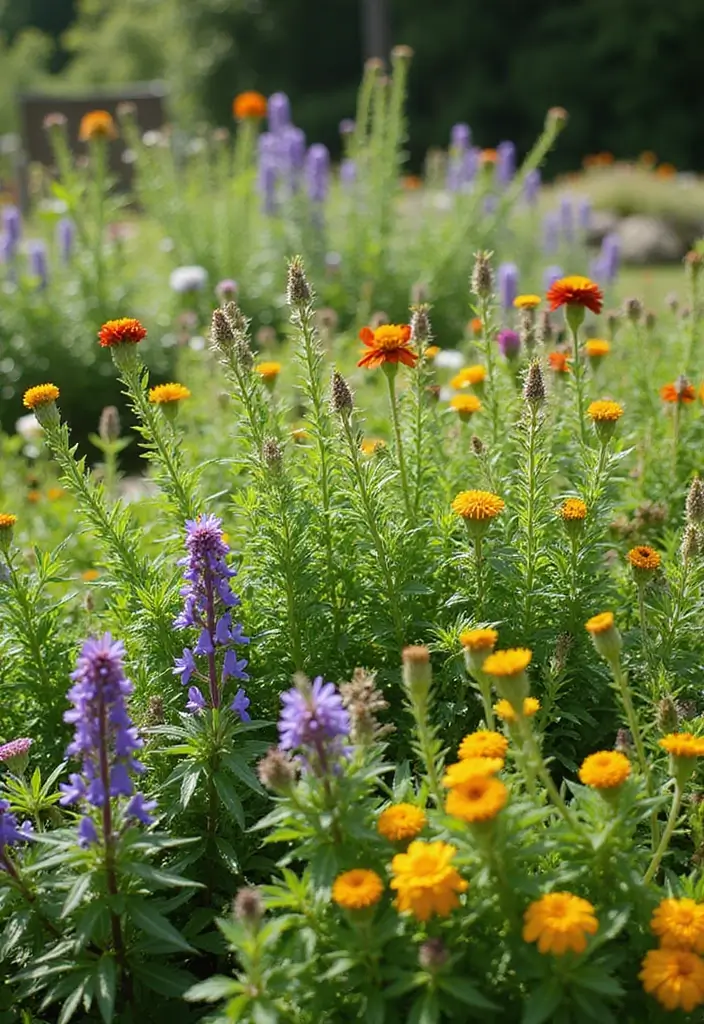
Combining herbs with edible flowers creates a stunning and flavorful garden. Herbs like basil and dill can be beautifully accompanied by nasturtiums or violas, enhancing both the visual and culinary experience. To get started, consider using the herb garden starter kit, which contains seeds for 10 different kitchen herbs, ideal for a windowsill planter.
These flowers not only add pops of color but can also be used in salads, desserts, or as garnishes. You can expand your options with the edible flower seed collection, which includes a variety of seeds such as viola, pansies, and nasturtium. Growing them together encourages biodiversity, making your garden more resilient.
Make sure to research which flowers pair well with the herbs you’re planting to enhance their flavor pairing. For optimal growth, you might also want to use the organic potting soil mix, designed specifically for container gardening, which can provide the nutrients your plants need.
Your herb garden can become a feast for the eyes and the palate! Creating a garden with edible flowers can elevate your cooking and make your garden more beautiful!
15. Hydroponic Herb Garden
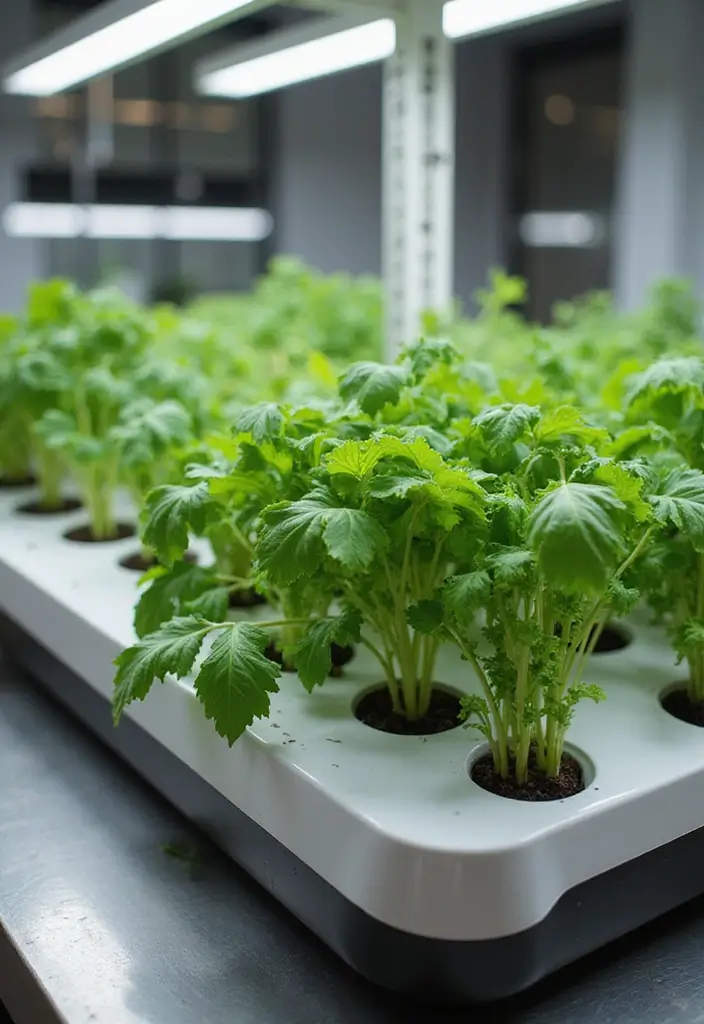
For those looking to explore innovative gardening techniques, consider a hydroponic herb garden. This method grows plants without soil, instead utilizing nutrient-rich water. Herbs like basil, mint, and cilantro flourish in hydroponic systems, thriving in moisture-rich environments.
To get started, invest in a good quality hydroponic system, such as the Ahopegarden Indoor Garden Hydroponics Growing System. This kit allows for easy maintenance and monitoring, making it a perfect entry point into hydroponics without feeling overwhelmed. Additionally, pairing your hydroponic setup with a nutrient solution like the General Hydroponics Flora Series ensures your plants receive the essential nutrients they need to thrive.
Not only is this system efficient, but it can also be set up indoors, giving you the flexibility to grow herbs year-round. To enhance your indoor growing experience, consider adding an LED grow light for indoor plants. This light provides the right spectrum for healthy growth and can be adjusted for different light cycles, ensuring your herbs flourish no matter the season.
Exploring hydroponics unlocks new possibilities in herb gardening and brings modernity to your kitchen!
Imagine harvesting fresh basil or mint from your indoor hydroponic herb garden—no soil required! Embrace this innovative approach and elevate your cooking, no matter the season.
16. Herb Garden with a Kitchen Theme
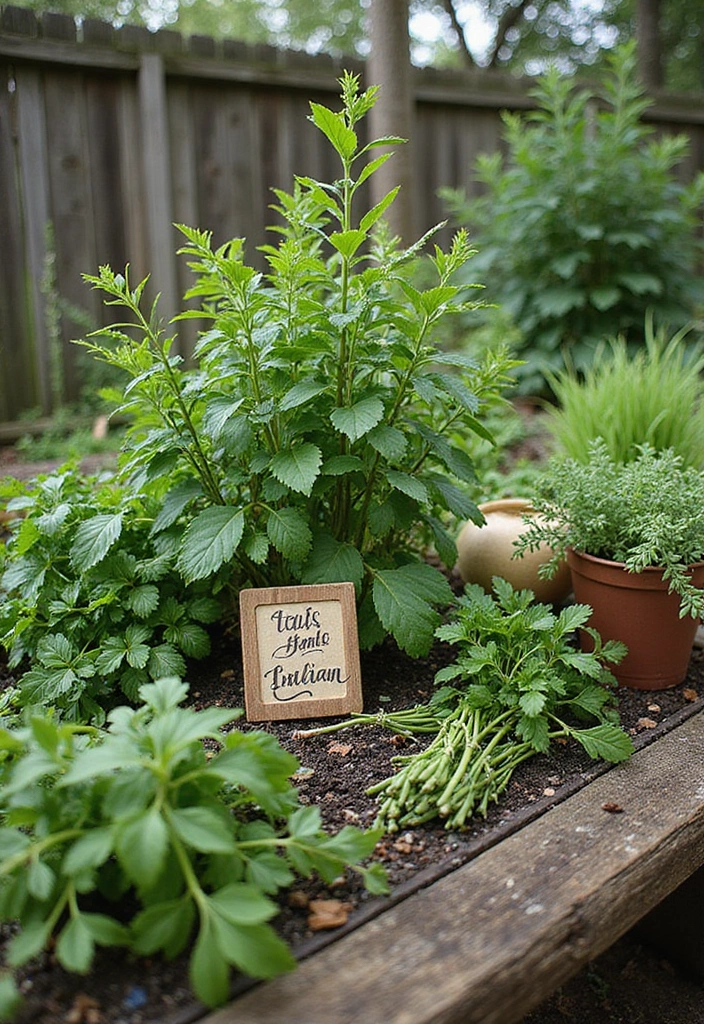
Create a herb garden that’s not just functional but also a reflection of your culinary passion! Design a themed herb garden directly related to your favorite cuisines—Italian, Mexican, or Asian.
For an Italian theme, consider growing basil, oregano, and parsley. In a Mexican-themed garden, herbs like cilantro and epazote can shine. This thematic approach can serve as culinary inspiration and enhance your cooking experience.
To help organize your herbs, you might want to use cute labels to identify each one along with its cuisine. These plant labels for herbs are not only practical but also add a decorative touch to your garden, turning it into a mini cooking station.
Additionally, if you’re starting from scratch, consider the herb garden starter kit. It comes with pots, soil, and tools, making it perfect for growing your themed herb garden right on your windowsill or countertop.
Creating a themed herb garden not only serves practical purposes, but can also be a delightful conversation starter, elevating your culinary adventures while ensuring everything you need is at your fingertips!
17. Herb Garden with a Fire Pit
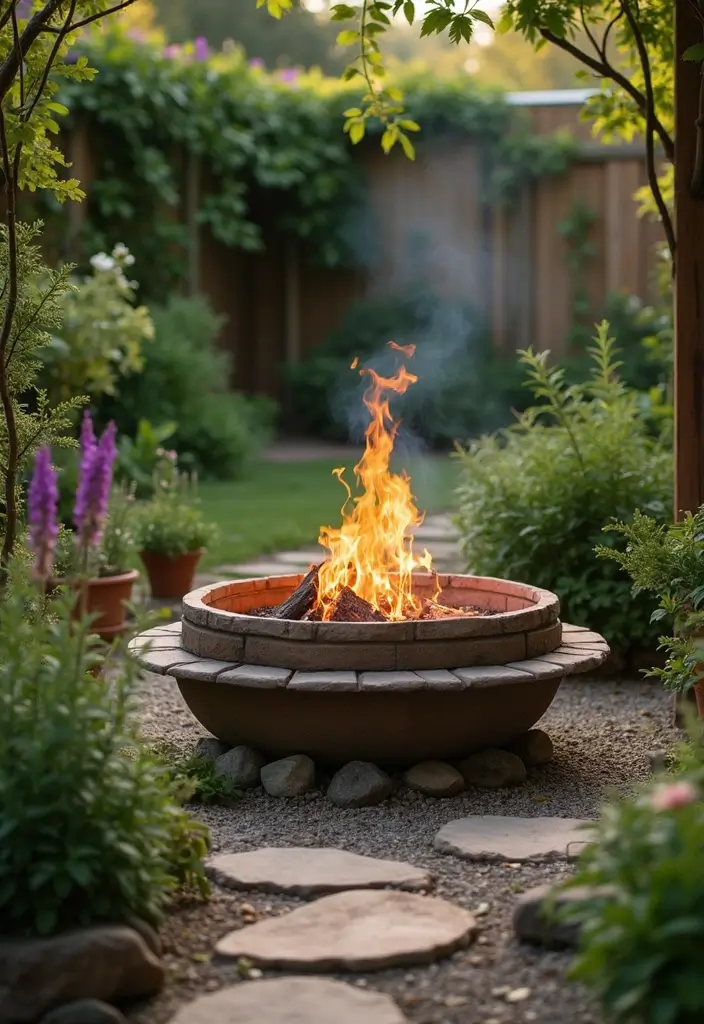
Imagine enjoying a cozy evening by a fire pit with fragrant herbs at your fingertips. Planning your herb garden around a fire pit not only enhances your cooking but also creates a wonderful outdoor space for entertaining.
You can grow herbs like sage, thyme, and rosemary, which can even be tossed into the fire for an aromatic experience! Positioning your herbs within close proximity encourages guests to enjoy fresh garnishes for grilled items or cocktails. To help define your garden space and provide comfortable seating around the fire pit, consider using stone or brick garden border edging. This will add an inviting atmosphere for gatherings while improving the overall aesthetic appeal.
To elevate your outdoor culinary experience, a fire pit cooking grate can be a fantastic addition. With this foldable grill grate, you can easily prepare delicious meals over the open flame, making the most of those fresh herbs you’ve cultivated.
If you’re just starting your herb-growing journey, an herb garden starter kit is a great way to kick off your herb garden with a selection of kitchen herbs. This kit is perfect for windowsills or countertops and provides you with everything you need to grow your favorite herbs right at home.
An herb garden combined with a fire pit creates a delightful setting for both culinary experimentation and social enjoyment!
18. Herb Garden in a Greenhouse
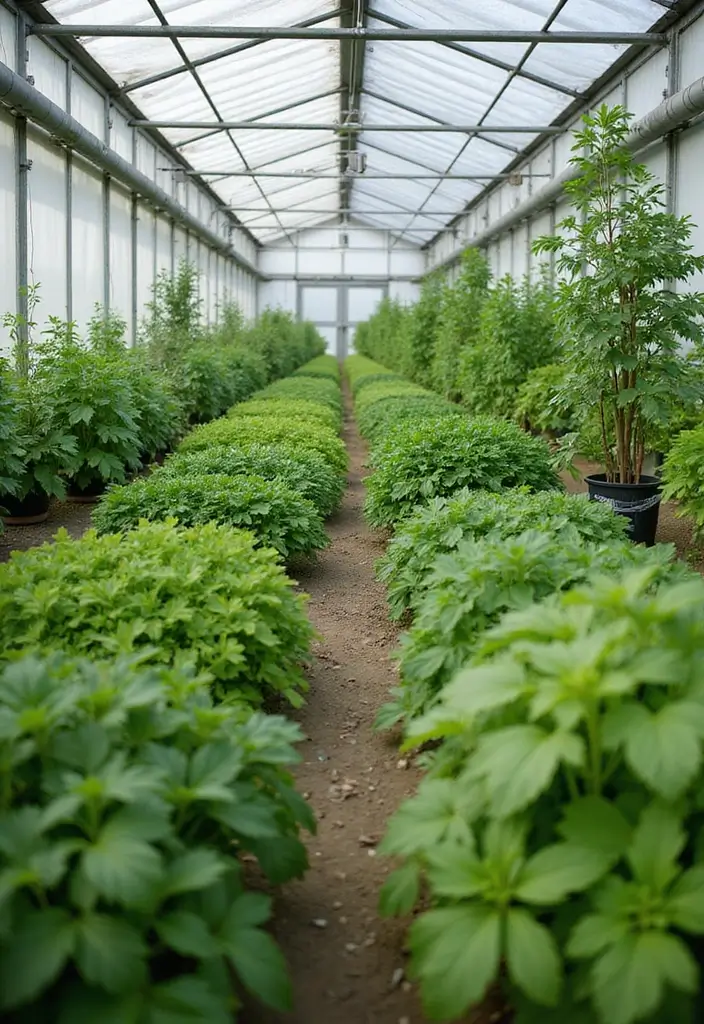
If you’re serious about growing herbs year-round, consider setting up a greenhouse garden. This controlled environment allows you to cultivate a diverse array of herbs regardless of the outdoor climate. You can experiment with herbs like basil, dill, and cilantro without worrying about seasonal changes.
To get started, a great option is the Greengro Greenhouse. This durable greenhouse kit features a thicken PE cover, multiple tiers, and heavy-duty construction, ensuring that your herbs are well-protected.
Moreover, having proper organization in your greenhouse can make a significant difference. Consider adding an herb shelf organizer to keep your herbs neatly arranged and easily accessible. This adjustable spice rack helps optimize your space, making it simpler to manage your various herb varieties.
For optimal growth, especially in lower light conditions, installing grow lights for indoor plants can be incredibly beneficial. The full spectrum, dimmable LED lights ensure your herbs receive the proper light they need to thrive, allowing for continuous growth even during the darker months.
A greenhouse can be a fantastic investment for any serious home cook looking to enhance their culinary practices! Creating a greenhouse herb garden opens up a world of gardening possibilities, allowing for creativity and continuous growth.
19. Herb Garden for Pollinators
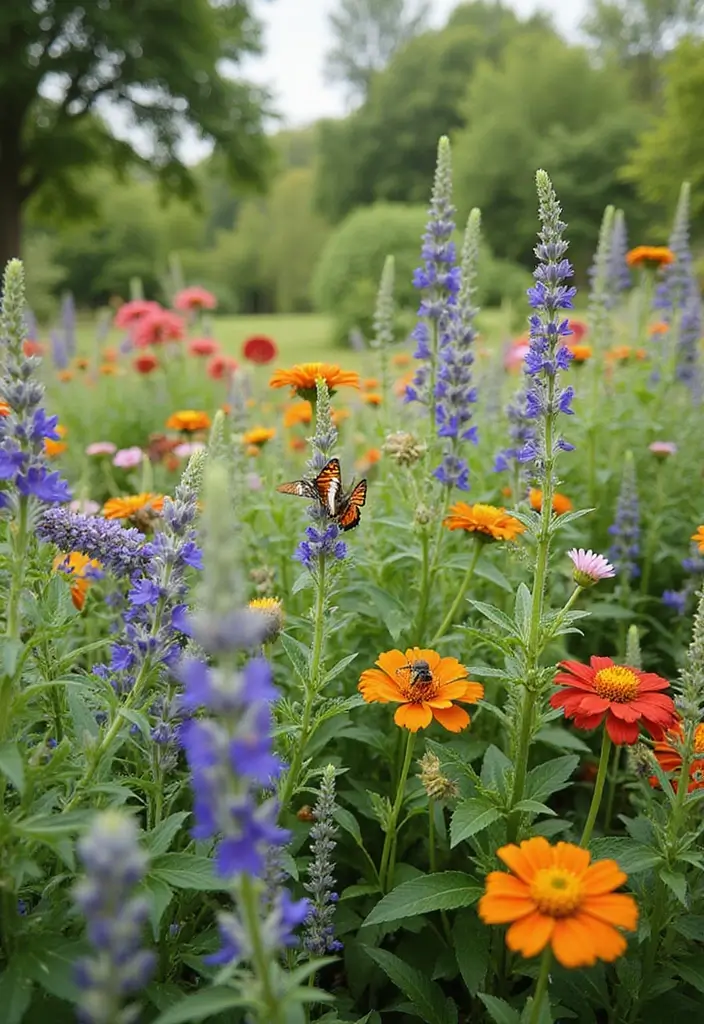
Creating an herb garden that attracts pollinators is a wonderful way to enhance biodiversity and support the environment. Herb varieties like lavender, borage, and thyme not only serve culinary purposes but also attract bees and butterflies. To get started, consider the organic herb seeds variety pack, which includes essential herbs like basil, cilantro, oregano, and thyme, perfect for both cooking and pollinator attraction.
By planting these herbs together, you contribute to a healthy ecosystem while enjoying fresh flavors in your dishes. For added appeal and vibrant colors, incorporate flowers like marigolds or zinnias. A great option for this is the pollinator-friendly flower seeds, which come in a bulk pack of 18 varieties, designed specifically to attract beneficial insects.
Additionally, if you’re interested in maximizing your herb growth indoors, the herb garden starter kit offers a hydroponics growing system that allows you to cultivate your favorite herbs right on your countertop with the help of an LED grow light.
Avoid using pesticides to keep your garden pollinator-friendly. Your herb garden can be a haven for beneficial insects, creating a lively and productive garden space. Crafting an herb garden for pollinators not only contributes to nature but also enhances your cooking experience with rich flavors!
20. Herb Garden for Health Benefits
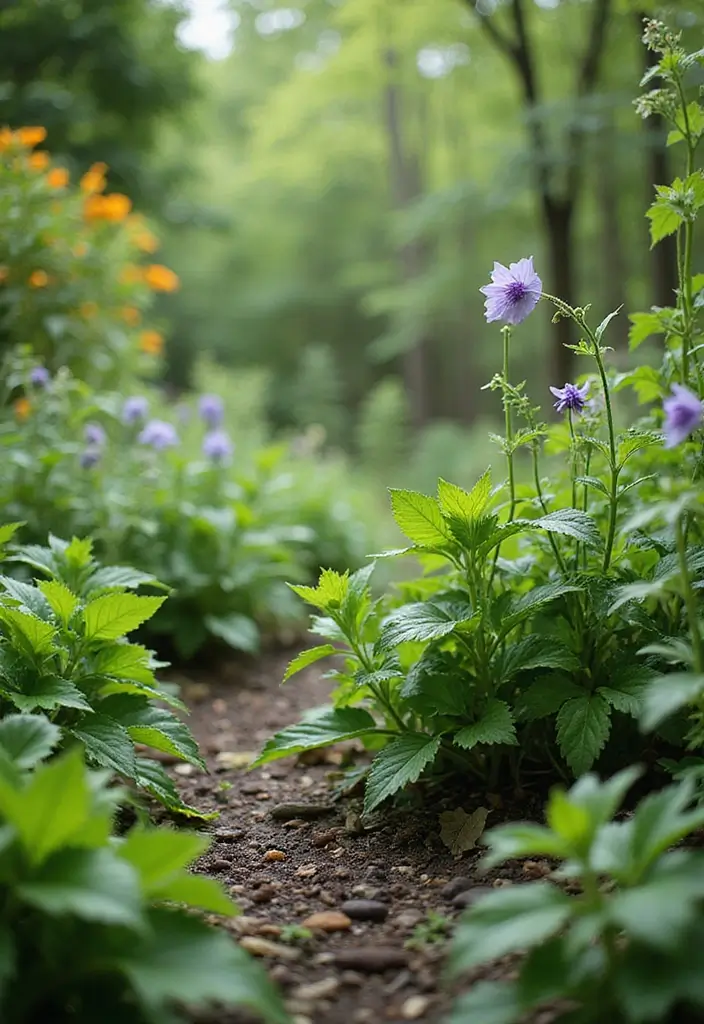
Focus on cultivating herbs renowned for their health benefits to create a wellness-centered herb garden. Herbs like ginger, peppermint, and chamomile can be used in teas and remedies, enhancing your overall well-being.
To get started, consider a herb garden starter kit. This complete set includes pots, soil, and tools, making it perfect for your windowsill or countertop. With everything you need in one package, you can easily create your own health-focused herb garden.
Researching the health properties of various herbs can help you design a garden that promotes vitality. Include herbs that aid digestion, boost immunity, or simply bring calming effects. A useful addition is a dedicated recipe book, like the Cook’s Herb Garden: Grow, Harvest, Cook. This book provides inspiration and guidance on how to use the herbs you grow, turning your garden into a valuable resource for both cooking and wellness.
Create space for recipes dedicated to using these herbs, perhaps with a little sign or a recipe book nearby! Your health-centered herb garden can enhance your culinary space while supporting your overall well-being.
21. Herb Garden with a Meditation Space
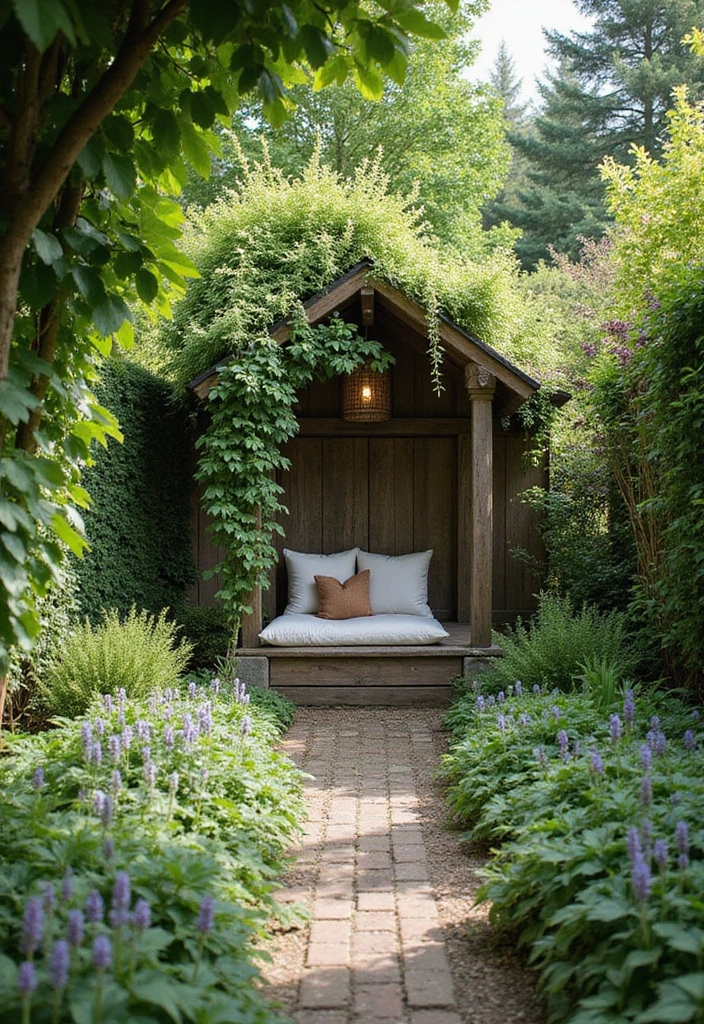
Designing an herb garden with a dedicated meditation area can provide serenity and relaxation. Incorporating fragrant herbs like lavender and chamomile not only enhances the atmosphere but also encourages tranquility.
To create a peaceful spot to unwind and connect with nature, consider adding an outdoor meditation bench. This cozy seating option invites you to spend more time among your herbs, allowing the soothing scents to elevate your meditation experience.
To further enhance the ambiance of your meditation space, you might want to include wind chimes. The gentle sounds they produce can create a zen atmosphere, helping you achieve a deeper state of relaxation.
For those looking to grow their own aromatic herbs, an herb garden starter kit can be a wonderful addition. This kit provides everything you need to cultivate a variety of kitchen herbs right in your own home, enriching both your meals and your meditation space.
Creating this blend of herbs and mindfulness can nourish both your body and soul, making your herb garden a personal retreat that encourages relaxation and a deeper connection with nature!
22. Community Herb Garden
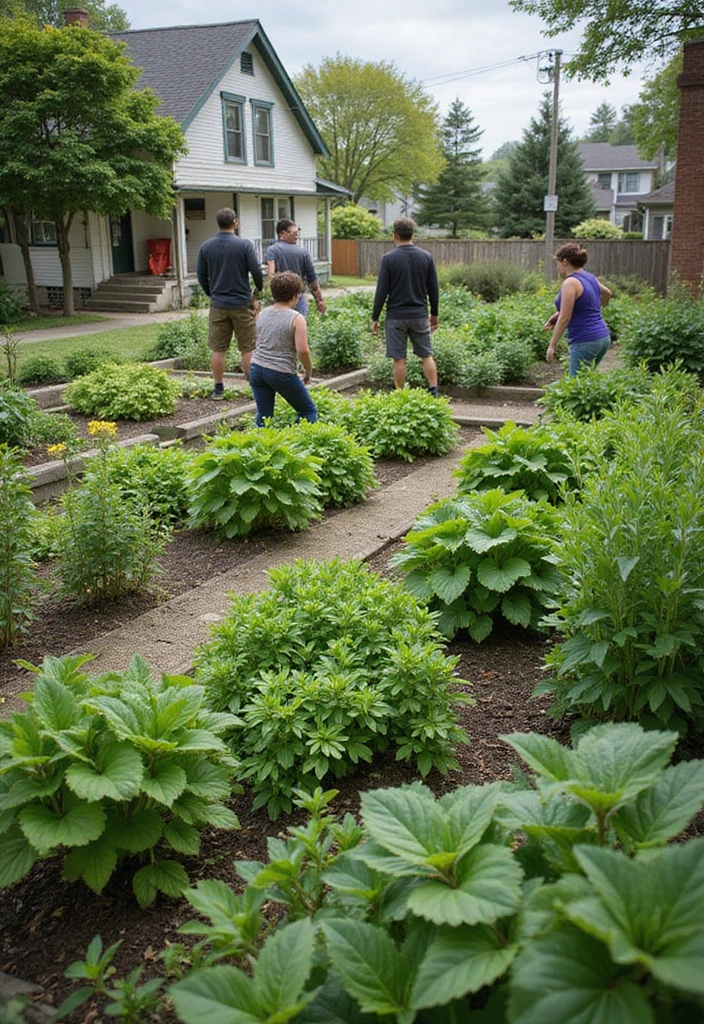
Joining forces with neighbors to create a community herb garden can bring people together and foster a sense of belonging. Everyone can contribute by choosing specific herbs they love, creating a diverse and rich garden.
This cooperative effort allows for shared gardening knowledge and best practices, encouraging a supportive environment. To help get your garden started, consider using the herb garden starter kit, which includes a hydroponics growing system and LED grow light, perfect for germinating a variety of herbs like basil, cilantro, and chives that can be freely shared among neighbors.
Organize regular community gardening days to maintain the space together, making it a delightful social event. Don’t forget to equip yourself with essential tools; a gardening tools set can make the upkeep easier and more enjoyable for everyone involved.
Additionally, using plant markers for herbs will help organize your garden, making it clear which herbs are planted where, enhancing the visual appeal and functionality of the space.
A community herb garden enhances relationships and provides fresh produce for all! Creating a community garden encourages collaboration, environmental awareness, and, of course, delicious cooking!
A community herb garden can turn strangers into friends and create a flavorful patch of unity. Share your favorite herbs and grow together—because great flavors are best enjoyed together!
23. Herb Garden Inspired by Travel
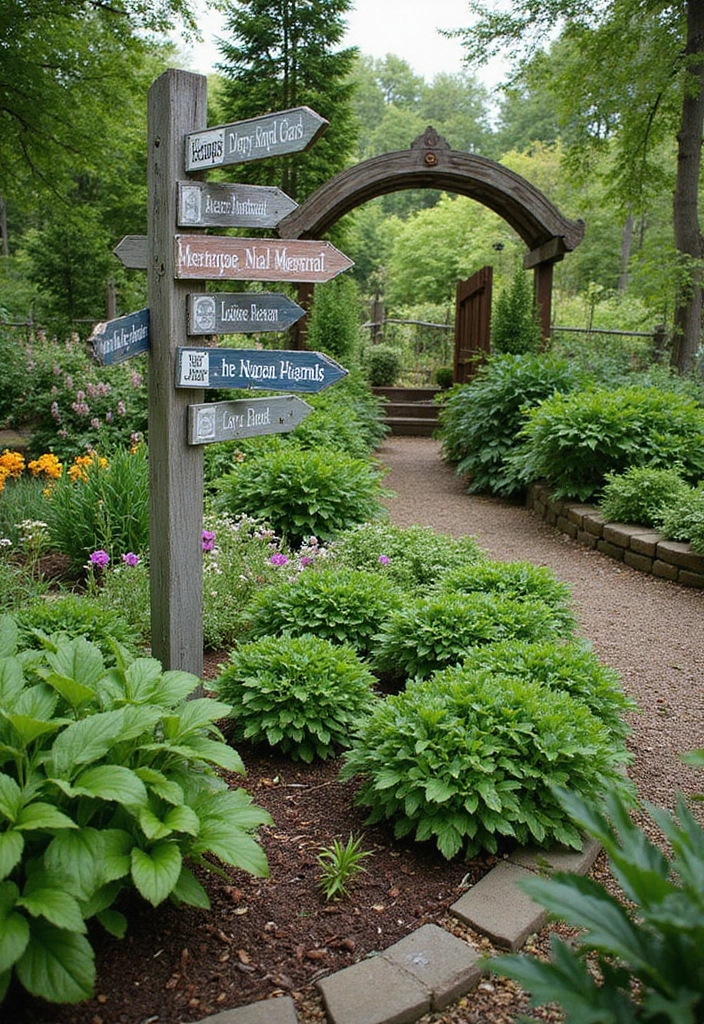
Let your travels inspire your herb garden! Create a garden featuring herbs that are staples in the cuisines you love from around the world. For instance, include cilantro for Mexican dishes, basil for Italian meals, and lemongrass for Asian cooking. This not only makes for a beautiful garden but also enhances your culinary experiences, allowing you to recreate your favorite dishes at home.
To get started, consider using a herb garden starter kit, which comes complete with pots, soil, and tools, making it easy to set up your indoor herb garden right on your windowsill or countertop.
Additionally, to make your garden feel more global, add signage or labels in fun languages. You can use garden plant labels to mark each herb, giving a nod to their culinary origins and enhancing the overall theme of your garden.
For a diverse selection of herbs to plant, the culinary herb seeds collection offers a variety of heirloom, non-GMO seeds that are perfect for growing indoors or outdoors. Designing an herb garden inspired by travel can immerse you in diverse cultures while making your cooking more exciting and flavorful. Enjoy the journey!
24. Herb Garden with Scented Varieties
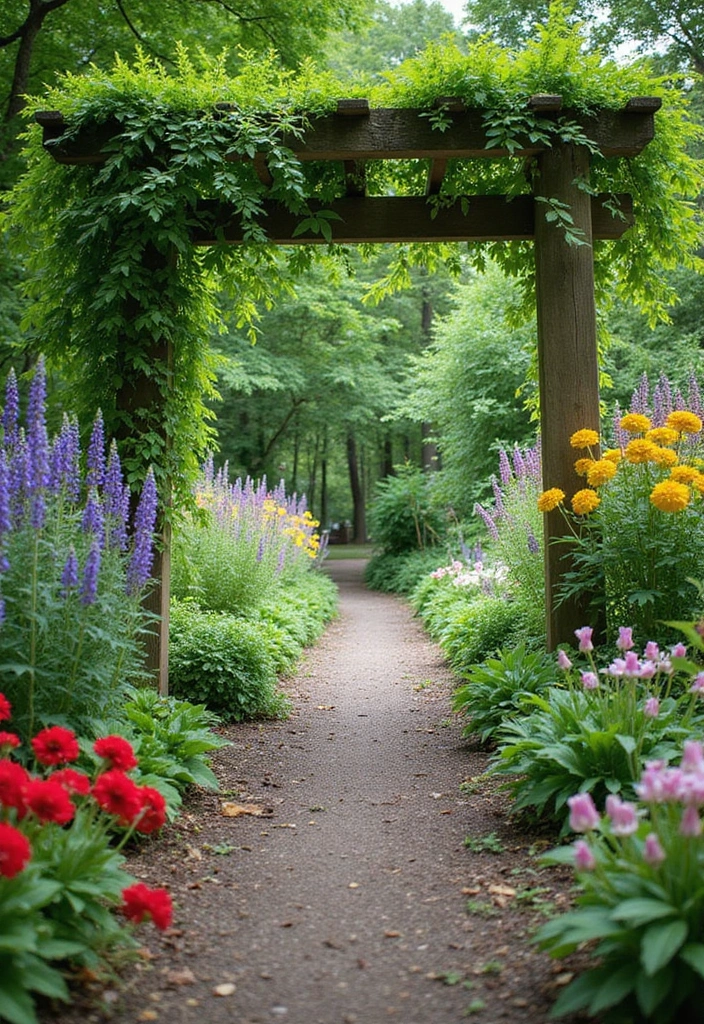
An aromatic herb garden filled with scented varieties can create an enchanting space that engages all your senses. Consider herbs like lavender, lemon balm, and mint to envelop your garden in delightful fragrances. To help you get started, the scented herb seeds variety pack includes a wonderful selection of herbs such as basil, cilantro, and of course, lavender, perfect for crafting your own aromatic oasis.
Scented herbs can stimulate the senses and enhance the cooking experience, providing natural flavor enhancements. Create a path lined with these herbs, inviting everyone to enjoy the aromatic benefits as they stroll through. To guide visitors through your garden, consider using garden pathway stepping stones. These decorative stones not only add charm to your garden but also ensure that guests can enjoy the scents up close without trampling on your beloved plants.
Crafting a scented herb garden can be a sensory delight and an aromatic journey, and with the right tools like the herb garden starter kit, you’ll have everything you need to cultivate your herbs indoors or outdoors. Embrace the beauty and fragrance of a well-planned herb garden that enchants the senses and elevates your culinary creations!
25. Seasonal Herb Garden
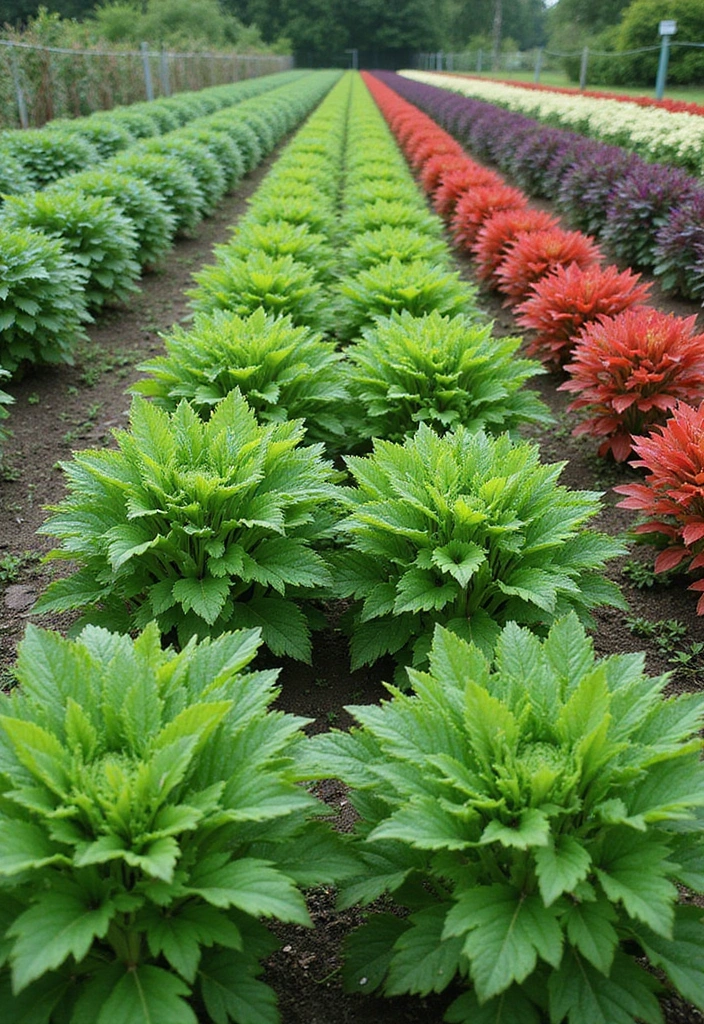
A seasonal herb garden allows for the creativity and excitement of rotating your herb selections based on the time of year. Planting cool-season herbs like cilantro and parsley in the spring, and warm-season herbs like basil and dill in summer can keep your garden fresh and diverse. This approach ensures that you always have an array of herbs ready for your cooking adventures while also allowing you to work with a rotating selection of flavors.
To help you stay organized and effectively manage your seasonal herb garden, consider using a Gardening Journal. This guided notebook allows you to log your planting schedules and keep track of seasonal herbs, ensuring you never miss an opportunity to plant your favorites at the right time.
Additionally, if you’re just starting out or want to enhance your indoor gardening experience, an Herb Garden Starter Kit can provide you with everything you need to grow popular kitchen herbs right at your windowsill. This kit makes it easy to begin your herb gardening journey and enjoy fresh herbs year-round.
Finally, to ensure you can identify and manage your herbs effectively, consider adding some Plant Markers to your gardening supplies. These durable, waterproof labels will help you keep track of your herbs, making it easy to know what you’ve planted and when it’s time to harvest.
Creating a seasonal herb garden invites variety into your culinary life and keeps your gardening creative!
26. Herb Garden with Unique Containers
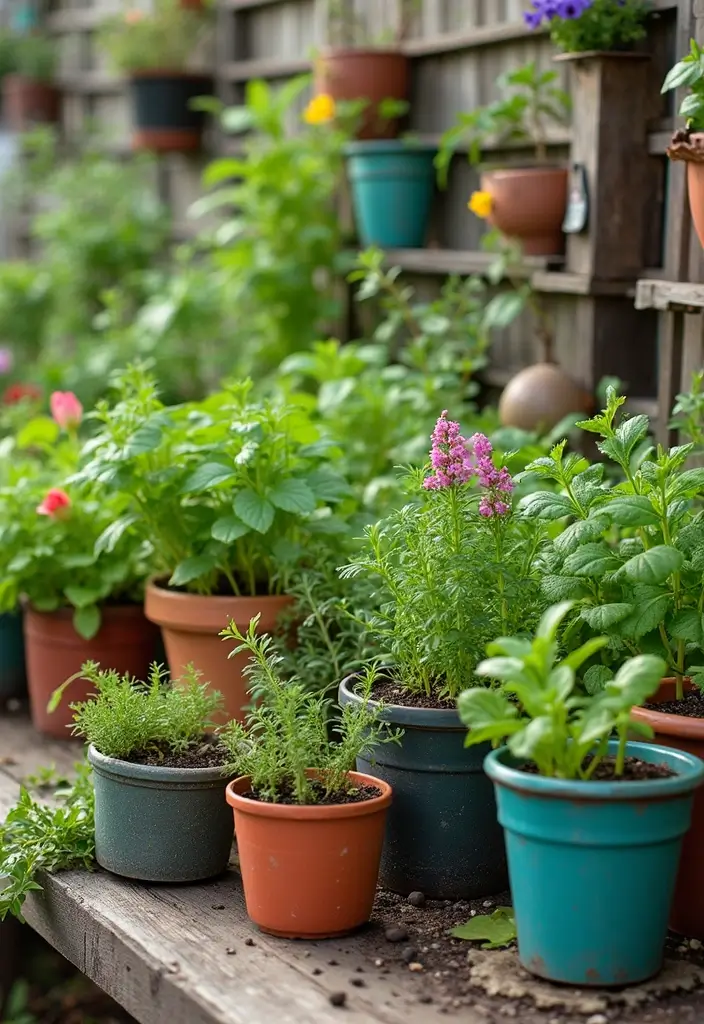
Revamp your herb garden by using unique or quirky containers that reflect your personality. You can get creative with options like the colorful painted flower pots, which come in a 6-pack and add a vibrant touch to your gardening style. These pots are not only fun but also practical, ensuring proper drainage for your herbs like chives, parsley, or small varieties of mint.
For those who prefer a more structured approach, consider the drainage hole herb planters. This set of rectangular planters is perfect for placing on your windowsill, providing multiple drainage holes to keep your herbs happy and healthy. They’re ideal for small spaces and can make your gardening experience both enjoyable and hassle-free.
If you’re looking for something truly distinctive, the quirky container garden kits feature a fun sun face design that brings a touch of whimsy to your garden. These hanging planters can be used for succulents or small plants, making them an eye-catching focal point in your outdoor or indoor space.
Using unique containers encourages creativity and can transform your garden into a playful and inviting space! Just remember to ensure all your containers have appropriate drainage holes and are deep enough for root growth.
27. Herb Garden for Kids
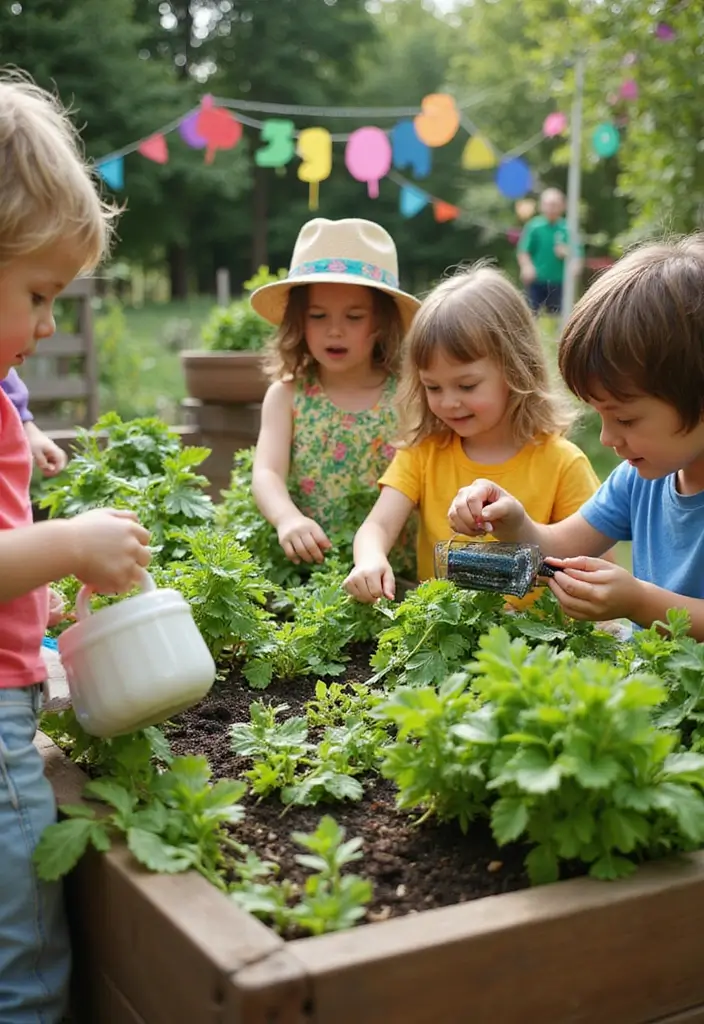
Involve children in gardening by creating a kid-friendly herb garden! Choose easy-to-grow herbs such as basil, mint, and chives, which can provide both fun and educational experiences. Letting kids plant, water, and care for their herbs encourages responsibility and a connection with nature.
To make the garden more engaging, consider using colorful planters for kids. These vibrant planters can brighten up the garden space and add a playful touch that will delight young gardeners.
You might also want to check out the herb gardening kit for kids. This kit allows children to decorate their pots with paint and stickers, combining gardening with arts and crafts. It’s an excellent way to spark creativity while teaching them about growing their own herbs.
Additionally, providing a set of gardening tools set for kids can make the experience even more enjoyable. With their own tools, children can feel like real gardeners as they dig, plant, and care for their herbs.
Tip: Incorporate fun activities like herb-themed crafts or cooking sessions to further enhance their experience. Building a kid-friendly herb garden can foster a love for nature and cooking while creating cherished family memories!
Conclusion
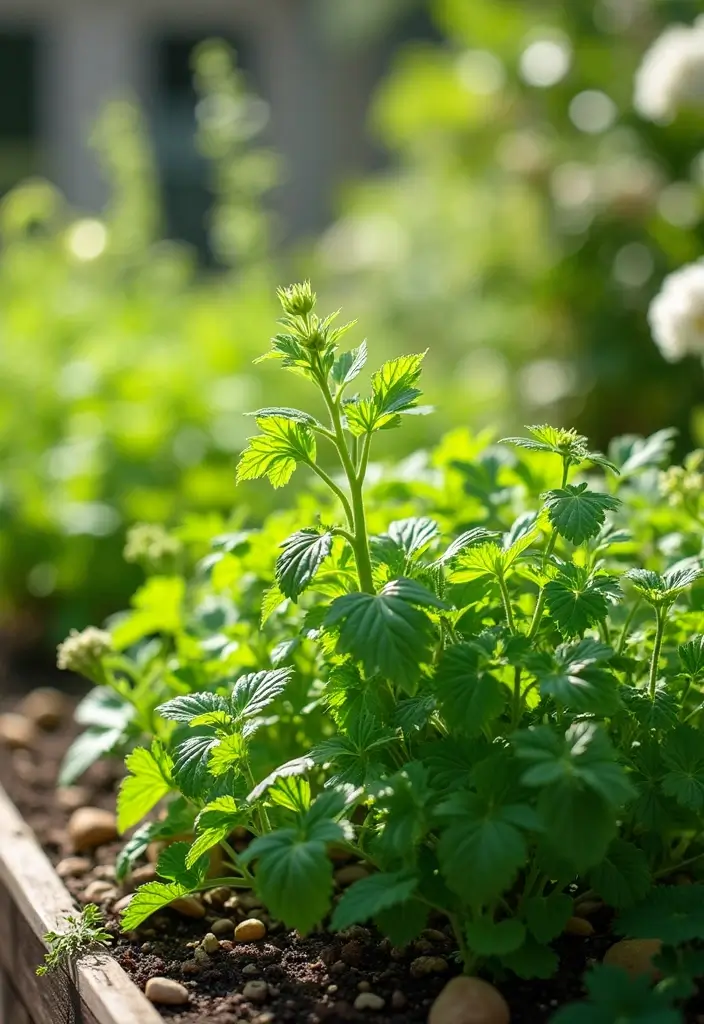
Creating an herb garden can be a rewarding journey, enriching your cooking and transforming your living space. From vertical gardens to unique containers, there are countless creative ideas to inspire your green thumb.
Consider starting with just a few herbs and gradually expanding your collection as you discover the joy of home gardening.
So, get your hands dirty, grow some fresh herbs, and enjoy the culinary delights they bring to your kitchen!
Note: We aim to provide accurate product links, but some may occasionally expire or become unavailable. If this happens, please search directly on Amazon for the product or a suitable alternative.
This post contains Amazon affiliate links, meaning I may earn a small commission if you purchase through my links, at no extra cost to you.
Frequently Asked Questions
What are some beginner-friendly herb garden ideas for those just starting out?
If you’re new to gardening, starting with container herb gardens can be a fantastic option! They offer flexibility and are easy to maintain. You can use pots, bins, or even repurpose old crates. Additionally, consider investing in herb garden kits designed for beginners, as they typically come with seeds, pots, and soil, making the process even simpler. Remember to choose easy-to-grow herbs like basil, mint, and chives to kick off your gardening journey!
How can I maximize space when creating an herb garden in a small area?
Maximizing space is key, especially in smaller areas! One of the best herb garden ideas for limited spaces is a vertical herb garden. This allows you to grow herbs upward, saving ground space while adding visual appeal. You can also consider a windowsill herb garden which is perfect for apartments. Using hanging baskets or wall-mounted planters can also help you create a lush herb garden without taking up valuable floor space!
What are the benefits of growing herbs indoors versus outdoors?
Growing herbs indoors offers numerous benefits! With an indoor herb garden, you can enjoy fresh herbs year-round, regardless of the weather outside. This is especially beneficial for those with limited outdoor space. Additionally, having herbs within arm’s reach in your kitchen can inspire more cooking adventures and elevate your dishes with fresh flavors. Just ensure your indoor garden gets plenty of sunlight, or consider using grow lights to keep those herbs thriving!
How can I incorporate herbs into my cooking for maximum flavor?
Incorporating fresh herbs into your cooking can truly elevate your dishes! Start by snipping herbs right before you use them to capture their peak flavor. You can also create an herb-infused oil or vinegar for a delicious addition to salads and marinades. Don’t shy away from pairing herbs with various cuisines—try basil in Italian dishes, cilantro in Mexican recipes, or mint in Middle Eastern fare. Experimenting with different combinations will help you discover your unique culinary style!
What are some creative ways to style my herb garden for aesthetic appeal?
Styling your herb garden can be both fun and rewarding! Consider creating an herb spiral or using natural borders like stones or logs for a rustic look. Hanging planters or unique containers can also add a personal touch and showcase your style. If you’re feeling adventurous, try a themed garden that reflects your favorite cuisine, mixing herbs with edible flowers for a colorful and functional display. Your herb garden can be a beautiful addition to your home while providing fresh culinary delights!
Related Topics

